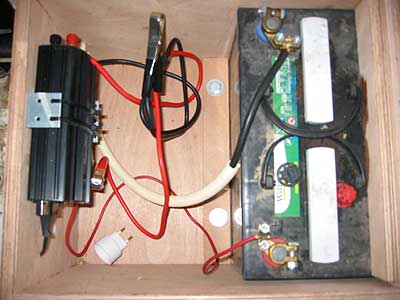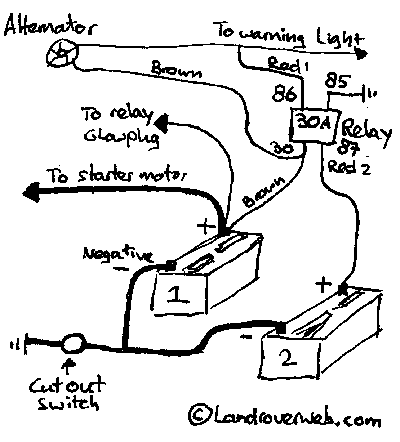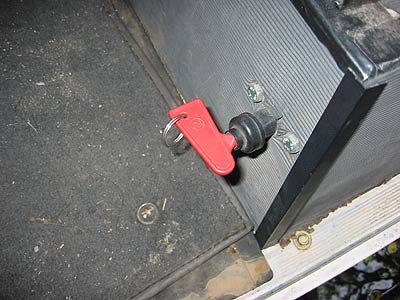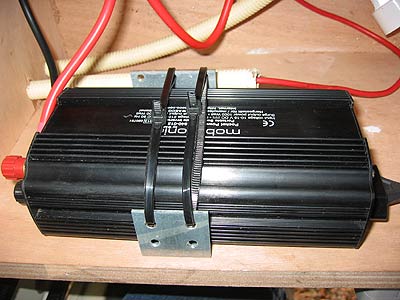Most vehicles will have one battery only and if you plan to fit a second one there will always be the question: how do I connect the dual battery set up?
There are several ways for doing it. You can buy an ‘intelligent high tech unit’ costing you a lot of money or you can go for the basic way by fitting a split charge relay. The benefit of the expensive kit will be that it should start charging your main battery first, if full it will start charging the 2nd. Basic relays will charge both batteries at the same time and if you want to DIY here you can find how to connect it into your car. Actually it is very basic, you will need a 30amp relay, connectors, some thick alternator wire and some battery cable.
How does it work?
They relay will make the 2nd battery charge as soon as the relay has been switch on by the alternator, so when your engine is running and the alternator starts charging it will operate the relay. Normally this will be indicated by the warning light on your dashboard switching off. The split charge relay is operated by the same wire as your charging light so all you will have to do is to connect a 2nd wire to this one (just split it and make a joint) and one will go to the warning light, the other wire to your relay. So as soon as the relay switches on the 1st and 2nd battery will be both charged.

Here you can see the 2nd battery box in my vehicle (picture above). At the left hand side the 220volt inverter and at the right hand side the 2nd battery. Red thin cable is the charge one coming from the relay. The thick red & black ones with clamps can be clamped on the battery to operate the inverter get the 220volt. The thick black cable (partly covered in the protecting flexible hose) is the negative lead coming from the negative pole of the 1st battery.
Cables needed:
The current charging the battery is very high which means you need a thick cable going from the alternator to the battery and on some Land Rover vehicles this will be a thick brown or red wire. It might first go to the starter motor and from there via the positive battery lead to the battery. (check your electrical circuit schedule for your specific vehicle) If there is no separate charging cable connected to the 1st battery just simply connect one from the positive pole to the relay.

On the picture you can see the HD relay I am using. However the same can be done with a cheap plastic 30amp one which you can buy at every corner!
The LH brown cable does go to the glow plug relay (diesel vehicles only) the other brown cable is coming form the positive battery pole/alternator charge output. The red one is operating the relay and is connected to the warning light feed also coming from the alternator. You can use a thin wire this one. At the back of the relay is the connection to the 2nd battery. Another thick red cable like the brown ones (covered with flexible hose for protection) is connected to this one. The thin black one is the negative wire going to the frame/earth to operate the relay. So as soon as the red wire is supplying a current it will operate the relay and inside the relay the brown and red (2nd battery feed) will be connected.
If you have the small plastic 30amp relay:
Connector 85 = chassis earth (black on picture)
Connector 86 = operating the relay (red 1 wire from warning light/alternator)
Connector 87 = charge to battery 2 (red 2 wire at the rear of relay on picture)
Connector 30 = charge feed from alternator and/or 1st battery.
Brown = Alternator to relay and diesel glow plug relay
Red 1 (thin) = From alternator to warning light and relay (operating)
Red 2 (thick = From relay to 2nd battery (charge)

The thick black cables on the drawing are the battery leads, the positive one will go to the starter motor and the negative one will go to the earth via the cut out switch.

It’s always wise to have a cut out switch for you battery and this one will disconnect both the batteries in one go from my vehicle.
220 volt inverter:
I did fit an inverter to my vehicle so I could e.g. plug in my laptop computer. It’s a very handy device and you can buy basic one like the one on the picture. Just connect it to the battery and you will get instant 220 volt! The units are available in several sizes depending on the output in Watts and 300W to 600W is a normal one which will allow you to run some basic equipment. A laptop, battery pack charger (cordless drill), working light or ghetto blaster!

I did strap the unit into my 2nd battery box but you can also keep it separate if you don’t want to fit it permanently to one vehicle only. This one uses two battery clamps but smaller once can be operated through the cigarette lighter.

At the outside of my battery box you can find the 220 volt power point! The grey cable at the bottom will go to another power point in the back. I did use these waterproof ones because Land Rover will always leak!




Good day, eh:
My questions are that as I plan using the second battery for starting only, will the relay prevent it from helping during start – as in for second storage only? I plan on a RedTop not just because it is 700cca instead of 650 with the YellowTop 34/78, but also it is about $100 Cheaper. If the RedTop goes flat on Start it’s toast. Would two Deep Cycle YellowTops be a better idea?